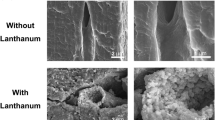Summary
An investigation designed to define relationships between endothelial channels and lysosomes was conducted in the mammalian brain microvasculature. Microvessels from normal and mechanically injured mouse brains were studied ultracytochemically for: (1) transport of horseradish peroxidase (HRP) protein tracer through endothelial channels, and (2) for acid phosphatase (AcP) activity as an enzymatic marker of lysosomes. Following traumatic brain injury for 1 week with 2 h circulation of intravenously injected HRP, selected brain slices were processed for ultrastructural localization of either HRP, AcP, or for both reactions together within the same tissue slices.
One week after blood-brain barrier (BBB) damage, the presence of HRP reaction product (RP) was observed within endothelial channels and vesicles of capillaries and arterioles with concomitant increase in lysosomal enzymatic activity of the endothelial cells bordering regions of brain damage. Lysosomes were observed to be directly connected to the endothelial channels. Our observations present cytochemical evidence for endothelial channel-lysosome connections which may suggest intralysosomal modification of blood-born materials before entering the neuropil. Such modification could have important immunological and/or metabolic significance.
Similar content being viewed by others
References
Arstila AU, Trump BF (1969) Autophagocytosis. Origin of membranes and hydrolytic enzymes. Virchows Arch B [Cell Pathol] 2:85–90
Asano G, Hishino M, Okubo K (1977) Electron microscopic study of vascular permeability. The vascular permeability induced by various pathological condition of rat brain. Jpn J Clin Elec Microscop 9:680–681
Beggs JL, Waggener JD (1976) Transendothelial vesicular transport of protein following compression injury to the spinal cord. Lab Invest 34:428–439
Brightman MW (1977) Morphology of blood-brain interfaces. Exp Eye Res [Suppl] 25:1–25
Brightman MW, Hori M, Rapoport SI, Reese TS, Westergaard E (1973) Osmotic opening of tight junctions in cerebral endothelium. J Comp Neurol 152:317–325
Bruns RR, Palade G (1968) Studies of blood capillaries. I. General organization of blood capillaries in muscle. J Cell Biol 37:244–276
DeBruyn PPH, Michelson S, Becker RP (1975) Endocytosis, transfer tubules, and lysosomal activity in myeloid sinusoidal endothelium. J Ultrastruct Res 53:133–151
Deurs B, Van (1978) Endocytosis in high endothelial venules. Evidence for transport of exogenous material to lysosomes by uncoated “endothelial” vesicles. Microvasc Res 16:280–293
Ericsson JLE (1969) Studies on induced cellular autophagy. I. Electron microscopy of cells with in vivo labeled lysosomes. Exp Cell Res 55:95–106
Florey L (1966) The endothelial cell. Br Med J 2:487–490
Garcia JH, Lossinsky AS, Nishimoto K, Klatzo I, Lightfoote W, Jr (1978) Cerebral microvasculature in ischemia. In: Cervos-Navarro J, Betz E et al. (eds) Advances in neurology, vol 20. Raven Press, New York, pp 141–149
Lossinsky AS, Garcia JH, Iwanowski L, Lightfoote WE, Jr (1979) New ultrastructural evidence for a protein transport system in endothelial cells of gerbil brains. Acta Neuropathol (Berl) 47:105–110
Lossinsky AS, Vorbrodt A, Iwanowski L, Wisniewski HM (1980) Ultracytochemical studies of endothelial channels in normal and injured mouse blood-brain barrier. J Neuropathol Exp Neurol 39:372
Majno G (1965) Ultrastructure of the vascular membrane. In: Hamilton WF, Dow P (eds) American physiological society-Handbook of physiology, section 2, circulation, vol 3. Williams & Wilkins, Baltimore, pp 2293–2375
Nag S, Robertson DM, Dinsdale HB (1977) Cerebral cortical changes in acute experimental hypertension. An ultrastructural study. Lab Invest 36:150–161
Novikoff AB (1963) Lysosomes in the physiology and pathology of cells. Contribution of staining methods. In: de Reuck AVS, Cameron MP (eds) Ciba foundation symposium on lysosomes. Little, Brown, Boston, pp 36–77
Novikoff AB, Holtzman E (1970) Cells and organelles. Holt, Rinehart and Winston, New York
Novikoff AB, Essner E (1962) Pathological changes in cytoplasmic organelles. Fed Proc 21:1130–1142
Peters A, Palay SL, Webster HdeF (1976) The fine structure of the nervous system. The neurons and supporting cells. Saunders, Philadelphia
Rapoport SI, Hori M, Klatzo I (1972) Testing of a hypothesis for osmotic opening of the blood-brain barrier. Am J Physiol 223:323–331
Reese TS, Karnovsky MJ (1967) Fine structural localization of a blood-brain barrier to exogenous peroxidase. J Cell Biol 34:207–217
Roggendorf W, Cervos-Navarro J (1978) Characterization of venules in the brain. In: Cervos-Navarro J, Betz E et al. (eds) Advances in neurology, vol 20. Raven Press, New York, pp 39–46
Shivers RR (1979) The effect of hyperglycemia on brain capillary permeability in the lizard,Anolis Carolinensis. A freeze fracture analysis of blood-brain barrier pathology. Brain Res 170:509–522
Smith RE, Farquhar MG (1965) Preparation of nonfrozen sections for electron microscope cytochemistry. RCA Sci Instr News 10:13–18
Spurr AR (1969) A low-viscosity epoxy resin embedding medium for electron microscopy. J Ultrastruct Res 26:31
Swift H, Hruban Z (1964) Focal degradation as a biological process. Fed Proc 23:1026–1037
Thorgeirsson G, Robertson AL (1978) The vascular endotheliumpathobiologic significance. Am J Pathol 93:803–848
Trump BF, Arstila AU (1975) Cellular reaction to injury. In: Lavia MF, Hill RB, Jr (eds) Principles of pathobiology. Oxford University Press, New York, pp 9–94
Westergaard E, Brightman MW (1973) Transport of proteins across normal cerebral arterioles. J Comp Neurol 152:17–44
Westergaard E, Go E, Klatzo I, Spatz M (1976) Increased permeability of cerebral vessels to horseradish peroxidase induced by ischemia in Mongolian gerbils. Acta Neuropathol (Berl) 35:307–325
Author information
Authors and Affiliations
Additional information
This work was supported by the Office of Mental Retardation and Developmental Disabilities of the State of New York
Rights and permissions
About this article
Cite this article
Lossinsky, A.S., Vorbrodt, A.W., Wisniewski, H.M. et al. Ultracytochemical evidence for endothelial channel-lysosome connections in mouse brain following blood-brain barrier changes. Acta Neuropathol 53, 197–202 (1981). https://doi.org/10.1007/BF00688022
Received:
Accepted:
Issue Date:
DOI: https://doi.org/10.1007/BF00688022




